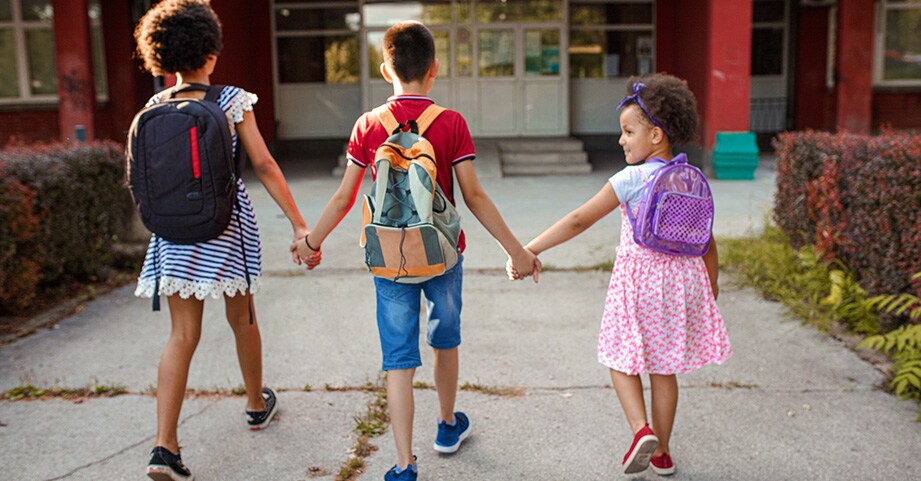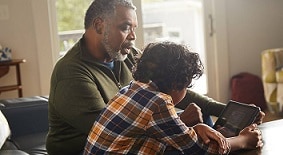How Much Should My Child's Backpack Weigh?
Kids and teens may not have to lug around massive textbooks these days, but devices, school supplies, gym clothes—not to mention all of those trinkets, treasures and leftover snacks hiding in the pockets—can make for one heavy backpack. To help prevent the back, neck and shoulder pain that can result from carrying this heavy load, here are some tips to help kids choose the best backpack and wear it correctly.
Kids may be focused on the way their backpack looks, but parents need to consider more than just colors, patterns and cartoon characters. Here are some key qualities you should be looking for in the perfect pack:
- Sized right: Bigger is not necessarily better. The more room there is in a backpack, the more your child will carry … and the heavier the backpack will be. See below for a guide on getting the right-size pack for every age.
- Two broad, padded shoulder straps: Having adjustable straps that are broad and distribute weight evenly between both shoulders is important. Both straps should stay even in length. Non-padded straps can be uncomfortable and dig into your child’s shoulders. But note that extra padding doesn’t necessarily mean less pain; fit is key.
- Padded back: This can provide increased comfort when the backpack is appropriately fitted and close to the back. It also provides protection from sharp objects that may poke a child’s back, like notebooks, rulers and pencils.
- Waist belt or chest strap: Belts and straps help redistribute the weight of the backpack more evenly across the body, so encourage your child to use them.
- Individualized, multiple compartments: These can help evenly distribute the weight of the contents throughout the backpack.
Include your child in the decision-making process, but help them make a smart purchase. This will allow them to tote their packs comfortably all year long and you won’t have to go searching for a replacement.

Getting the Right Fit
Choosing a backpack that fits your child properly is one way to prevent potential pain from wearing one. Every child is unique and each backpack will fit them differently, so be sure they try one on before you buy. Here is a guide to determine the right size backpack to consider.| Class | Backpack height | Backpack depth |
|---|---|---|
| Preschool | 11 in. | 6 in. |
| Kindergarten | 12 in. | 6—6.5 in. |
| Elementary School | 12—15 in. | 7—8 in. |
| Middle School | 15—16.5 in. | 8—9 in. |
| High School | 17—19 in. | 9—9.5 in. |
| College | 19 in. | 9—9.5 in. |
There’s no point in picking out the perfect backpack unless your child or teen is committed to wearing it the way it was intended. Here are some tips to help ensure that kids are carrying their packs correctly.
Proper Packing
The first step is to pack the backpack so that most of its weight rests in the curve of your child’s lower back. Pack the heaviest items, like computers and books, closest to the body and place other items equally on the right and left sides.
The Right Way to Carry a Backpack
“Your child should wear the backpack so that it puts weight at the core muscles of the body: the back and abdominal muscles,” advises Children’s orthopedist Sajith Azerf, MD, MPH. To limit strain elsewhere in the body, kids should:
- Bend their knees and squat to pick up their backpack while keeping their backs straight.
- Use both shoulder straps. Slinging a backpack over one shoulder can put too much pressure on those muscles.
- Adjust the shoulder straps so that the backpack rests in the middle of the back. The backpack should go from waist level up to about 1–2 inches below the shoulders.
- Make sure the bottom of the backpack rests in the curve of the lower back. A backpack should never sit more than 4 inches below the waistline (belly button).
- Secure the waist or chest strap. This helps keep the backpack close to the body and distributes the weight more evenly.
How to Know When a Backpack Is Too Heavy
As a general rule, backpacks shouldn’t weigh more than 15% of your child’s body weight. This means a child who weighs 100 pounds shouldn’t have a backpack that weighs more than 15 pounds. If your child needs to lean forward to support the backpack’s weight, then it’s too heavy. As an alternative, consider using a rolling backpack if your school allows.
Here are some other easy ways kids can lighten their load:
- Clean the backpack weekly and take out unneeded items.
- Store items in a locker when possible.
- Take only what’s needed to school.
The Lowdown on Kids and Back Pain
Back pain is not uncommon in kids and teens. “If a child has pain, numbness or tingling in their back, shoulders or neck, a heavy backpack is often to blame,” says Dr. Azerf. “The symptoms should resolve on their own after a period of rest. Just be sure to adapt your child’s backpack habits to prevent future pain and strain.” Also important to note: Backpacks do not cause any type of scoliosis or worsening of scoliosis, so if you have concerns about your child’s spinal alignment, it’s best to talk to their doctor or a pediatric spine specialist.

Where you take them matters.
Request an appointment with the only nationally ranked orthopedic program for kids and teens in Georgia, and we’ll help you understand your child’s diagnosis and create a comprehensive treatment plan.
Make an AppointmentSajith Azerf, MD, MPH, an orthopedic physician, recently completed his nonoperative pediatric fellowship training at the University of Wisconsin School of Medicine and Public Health. Previously, he completed his residency at Helen DeVos Children’s Hospital. He specializes in nonoperative musculoskeletal conditions, including clubfoot, gait abnormalities, non-operative management of scoliosis and fractures.
This content is general information and is not specific medical advice. Always consult with a doctor or healthcare provider if you have any questions or concerns about the health of a child. In case of an urgent concern or emergency, call 911 or go to the nearest emergency department right away. Some physicians and affiliated healthcare professionals on the Children’s Healthcare of Atlanta team are independent providers and are not our employees.
Contact Us 404-255-1933




